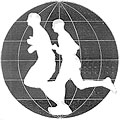
The World Runners Club
The World Runners Club was founded officially on 1 December 2013, with the inaugural members being the first two persons to have completed undisputed and fully documented runs around the world. These founding members are Jesper Kenn Olsen from Denmark and Tom Denniss from Australia.
Jesper completed a world run of 26,232 km from 2004 - 2005 and a second world run of 36,917 km from 2008 to 2012. Tom Denniss completed a world run of 26,232 km from 2011 - 2013 and holds the present fastest time for a world run. More about these runs can be found at www.worldrun.org (Jesper) and www.tomsnextstep.com (Tom).
A major purpose of The World Runners Club is to set clear standards for what "a world run" is, and to suggest how proper documentation should be implemented. These guidelines are provided to ensure this new frontier of ultra running is as credible and universally accepted as any other running event. It is also the aim of The Club to provide the official definition of a run around the world, consistent with the rules as defined by the official authority on such runs, the Alternative Book of Records.
To ensure this, and to encourage future world runners to use a mutual standard of credible and honest runs, we have provided this simple set of rules to follow. The rules can fairly easily be monitored and it is the aim of The Club to monitor such future runs, and to support runners who adhere to the standards of a proper and serious attempt.
Rules of The Club
The following are the minimum requirements for admission to the World Runners Club. However, admission is entirely at the discretion of the members of the World Runners Club. Past performances and credibility may be taken into account when evaluating the admission of a prospective new member.
Documentation will be of critical importance when evaluating the efficacy of any application to the World Runners Club. While there is no single mandatory form of documentation required, a policy of "the more, the better" will apply. Examples include, but are not limited to, logbooks (written and online), photographs documenting the runner in given locations, GPS-tracking records, real-time tracking of the runner's location on their website, and the public announcement of the route and timing of the run. These latter two examples are of special significance as they signal the runner is open for other runners and the general public to meet the runner at any time on the course, even unannounced.
- The runner must start and finish at the same place (except when starting on the edge of one continent and finishing on the edge of a fourth continent).
- The runner must cover a total of at least 26,000 km on foot.
- The runner must cross at least four continents from .coast to coast., covering a minimum of 1,000 km on each continent. The two "coasts" of any given continent must front different oceans#+. A tolerance of 1 km from the waters of the ocean is allowed. The four .core. continents must be crossed contiguously. (i.e. no gaps).
- The order of the four continents (and any additional land masses) that the runner takes must be longitudinally consecutive. For example, an acceptable order would be Europe, Asia, Australia, North America, South America. An example of an unacceptable order would be Europe, Australia, South America, Asia, North America.
- The runner must pass through antipodal points, within a tolerance of ten degrees of latitude and longitude.
- The runner must run more than 50% of the total distance. (i.e. walk less than 50%).
- The runner may take as many breaks as desired, with a cumulative total of one year as the maximum for such breaks. The runner may do as he/she pleases during these breaks. Any time incurred during breaks, however, will be included as part of the runner.s official time.
Support from The Club
The World Runners Club is happy to support future world runners with their advice, contacts, and knowledge if the runner is deemed to be making a legitimate attempt at completing a world run. Over time The Club may also take on charity events and other goals.
A runner who plans to do a world run according to the definition above can receive official notice from The Club, and the planned or ongoing run and its associated website can appear as an "ongoing attempt" on the website of the Word Runners Club, so long as proper documentation is used. The runner may refer to the monitoring by The Club in his/her official promotion of the run.
Register an attempt
If you wish to contact The Club in relation to advice etc. regarding a planned, ongoing, or past world run attempt, please contact by email:
- Jesper Kenn Olsen - jesper@worldrun.org
- Tom Denniss - tom.denniss@oceanlinx.com
- Phil Essam - pandbessam@bigpond.com
The Club can also be reached by traditional post at
The World Run,Farumgydevej 11,
3520 Farum.
Denmark.
Joining The Club
Any runner who has completed a properly documented run around the world and fulfilled the rules stated above can be accepted into the World Runners Club. This happens by unanimous vote among the members after careful considering of the documentation and integrity of the attempt.